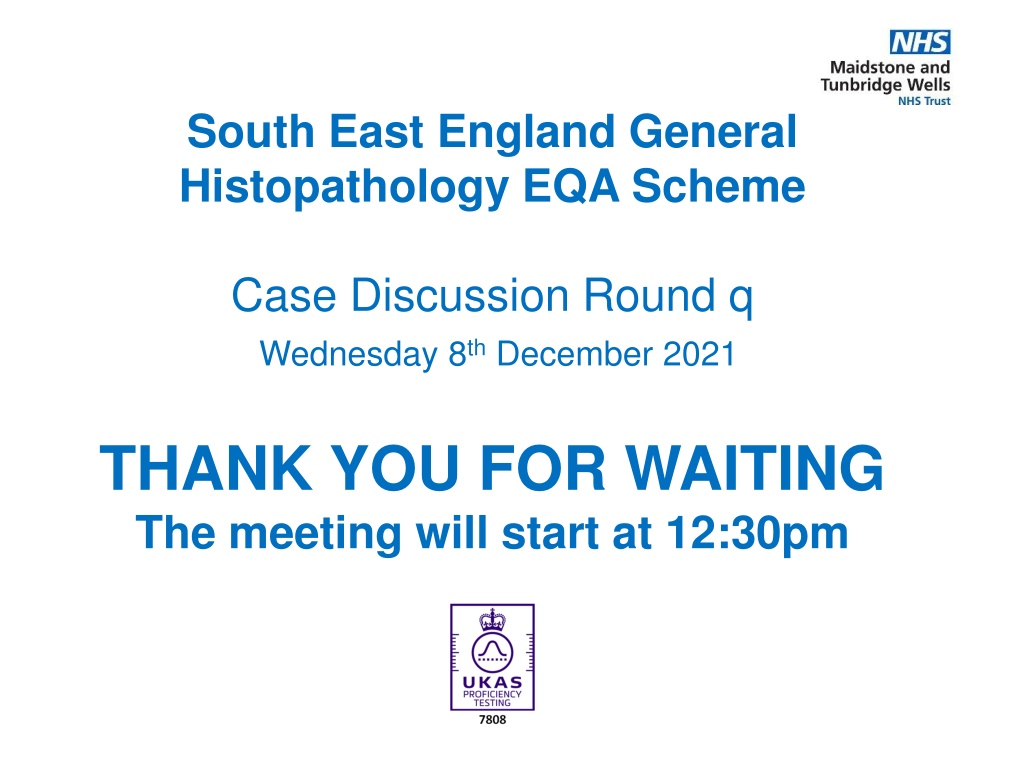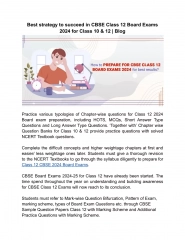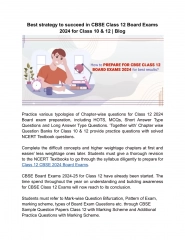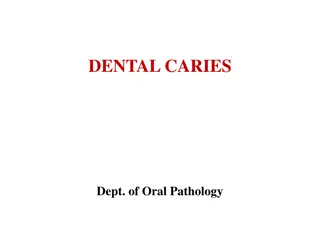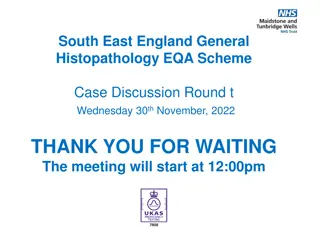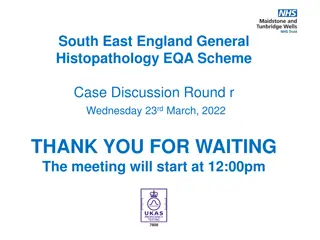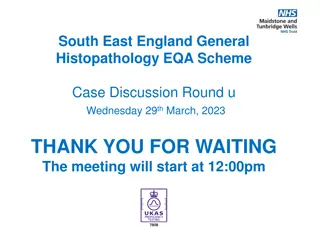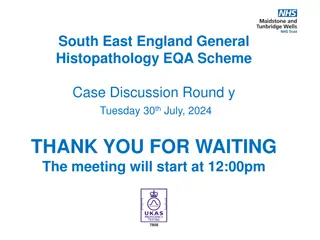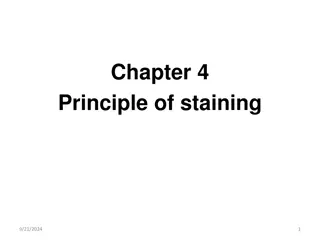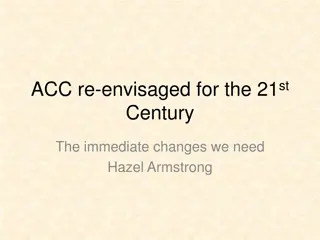South East England General Histopathology EQA Scheme Case Discussion Round Q
The South East England General Histopathology EQA Scheme is holding a meeting on Wednesday, 8th December 2021 for case discussion and review. The agenda includes reviewing cases and preliminary scores, maintaining meeting etiquette, and discussing meeting terms of reference. Participants are reminded of meeting protocols such as muting when not speaking and using hand raise features for questions. The meeting serves as an educational exercise and an opportunity to explain scoring decisions and case exclusions. Attendance may earn participants an additional CPD point. The meeting emphasizes the importance of feedback and participation rules for case consultations and merging diagnostic categories.
Download Presentation

Please find below an Image/Link to download the presentation.
The content on the website is provided AS IS for your information and personal use only. It may not be sold, licensed, or shared on other websites without obtaining consent from the author. Download presentation by click this link. If you encounter any issues during the download, it is possible that the publisher has removed the file from their server.
E N D
Presentation Transcript
South East England General Histopathology EQA Scheme Case Discussion Round q Wednesday 8thDecember 2021 THANK YOU FOR WAITING The meeting will start at 12:30pm
Meeting Etiquette 4 3 2 1 Mute your mic if you re not speaking Wait for the Chair person to call on you before you unmute your mic Use the raise hand Or chat feature to raise questions or share ideas If your camera is on, everyone can see you Remember Everyone can see your chat comments 6
Agenda 1. Welcome & Introduction of Scheme Staff 2. Meeting Terms of Reference 3. Case and Preliminary Score Review a) Case 829 838 b) Educational Cases 839- 840 4. Questions / comments
This meeting is held between the end of case consultation and results being issued and replaces the additional final week of the case consultation. This meeting is an educational exercise; an opportunity to explain the reasons behind scoring and merging or why cases were excluded. For clarity, this is not an opportunity to alter merging decisions, as participants have that opportunity during the Case Consultation period. An additional CPD point will be awarded to those who attend, and it will be added to the annual certificate. We always welcome any feedback good or bad you may have about today.
CaseConsultation 143 responses received for round q 86 responses received for consultation 60% QUORATE Basic Rules regarding Case Consultation and Merging Diagnostic categories: If you are exempt from a category, your consultation response to that case is also not counted Each case must have received a consultation response from at least 50% of those that answered it For a merge to be automatically accepted, more than 50% of consultation respondents must agree Between 40-50% agreement, the merge will be accepted only with the agreement of the Organiser (i.e. clinically valid). The consensus CAN be over-ridden if there are clinically valid reasons for doing so. These are recorded, and reviewed at the AMR.
Case 829 Miscellaneous Specimen: Cyst Submitted Diagnosis: Squamous inclusion cyst. Submitted Clinical Macro Immuno Image link Preliminary Results Final Merge Results M38. Left submandibular region (level Ib) cystic mass measuring 3.7cm in greatest dimension A cyst measuring 35mm with smooth outer surface and containing creamy soft material. In the same container there are multiple lymph nodes. N/A Click here to view digital image 1. Branchial Cleft Cyst 4.04 2. Epithelial / Epidermoid cyst 0.49 3. Lymphoepithelial cyst 5.33 4. Tonsillar cyst 0.07 We will be merging diagnoses 1 and 3 69% agreement from 86 responses General Comments All benign cystic lesion. Correlation with the topographic site. 1 and 3 may look identical; 1, 2, and 3 are effectively identical for management. Presence of lymphoid tissue suggest Branchial cleft cyst and lymphoepithelial cyst. A lot depends on radiology as the history does not clearly mention the site. These diagnoses have similar appearances are located in the same site Not a suitable case for general EQA as head and neck is a highly specialised area
Case 830 Respiratory Specimen: Lung Biopsy Submitted Diagnosis: Lung Adenocarcinoma Clinical Macro Immuno Image link Preliminary Results Final Merge Results F76. Likely lung Ca with bone mets Tan core measuring 15mm Positive: CK7, TTF1, Negative: CK20, CA125, Napsin A, CDX2, ER, PR, GCDFP, WT1, PAX8, Gata3, CK5/6, p63 1. Primary lung adenocarcinoma 8.98 2. Metastatic thyroid carcinoma 0.44 3. Carcinoma. Primary 0.58 /metastatic not stated We will not be merging any diagnoses Click here to view digital image 70% agreement from 81 responses General Comments: Favour lung but not definitive Correlation with radiology findings is essential for confirmation of primary. I think a diagnosis of carcinoma without giving differentiation (squamous vs adeno) and without an attempt to distinguish primary versus metastatic is a poor effort, especially when provided with a panel of immunohistochemistry. Metastatic thyroid carcinoma not at all likely if PAX8 negative Pax8 neg excludes thyroid. PAX8 is usually positive in thyroid carcinomas (negative in this case). That s why this is likely lung primary but in the end it s a clinic-path decision. This case also needs CPC and cannot be diagnosed just on the basis of immunohistochemistry and to call this as either lung primary or metastases from thyroid without excluding each other clinically and on radiology seems unsafe to me personally Both diagnoses could be appropriate for the immunopanel provided. A further thyroglobulin stain is needed to differentiate between these two primary sites Based on the immunoprofile difficult to distinguish 1 and 2. IHC panel not so useful, needs clinical imaging correlation. The correct answer is lung adenocarcinoma ( primary is not a histological diagnosis)
Case 831 Breast Specimen: Breast Submitted Diagnosis: Intraductal Papillary Carcinoma Clinical Macro Immuno Image link Preliminary Results Final Merge Results F66. Left mastectomy and SLNB Left mastectomy weight 1337grams, dimensions 180mm ML, 220mm SI, 75mm AP. Nipple bearing ellipse of skin 205 x 150mm. Poorly defined firm lesion 30mm across present centrally, 25mm away from nipple. p63 - occasional positive cells at periphery of ducts. Click here to view digital image 1. In-situ / Intraductal / Intracystic / 3.04 Encysted Papillary carcinoma 2. DCIS NOS 0.22 3. papillary DCIS ungraded 2.96 4. papillary DCIS low grade 0.43 5. papillary DCIS intermediate grade 2.25 6. papillary DCIS high grade 0.87 7. Atypical / possible / suggestive of DCIS 0.09 8. Intraductal papillary lesion / 0.15 papilloma / Nipple adenoma We will be merging diagnoses 1, 2, 3, 4, 5 & 6 42% agreement from 81 responses ER - strongly and diffusely positive in the epithelial cells. A wide range of merges were suggested but almost all included diagnoses 1-6 and excluded diagnoses 7 & 8 General Comments: Recognition and labelling as a carcinoma (2, 3, 4, 5, 6) even if terminology is not up to date All managed the same way but this is not a low-grade lesion Merge DCIS diagnosis? Think enough to call DCIS, not enough for high grade. All managed the same way but this is not a low-grade lesion A number of different entities have been conflated in diagnosis #1 (intracystic and encysted papillary carcinoma are synonyms, but I think in situ papillary carcinoma and intra-ductal papillary carcinoma should really be merged with papillary DCIS). 1-6 all impart DCIS diagnosis, which requires same management Take a screening EQA approach divide as benign, atypical, insitu, (invasive) Clearly an EPC w/o invasion Papillary configuration with lack of myoepithelial cells consistent with papillary DCIS Could be any of these entities further excision will be recommended on all these entities. Papillary DCIS implies low grade intrinsically. Encysted papillary Ca and papillary DCIS are a specialist distinction which is essentially academic. Treatment will be the same regardless.
Case 832 Endocrine Specimen: Total thyroidectomy Submitted Diagnosis: Minimally invasive (capsule only) follicular carcinoma Clinical Macro Immuno Image link Preliminary Results Final Merge Results F53. Total thyroidectomy with a right dominant nodule - for Graves disease Thyroid with right lobe 55x20x25mm & left lobe 30x25x15. In the right lobe is a tan haemorrhagic nodule 15mm maximum. Rest of thyroid has a nodular cut surface N/A Click here to view digital image 1. Thyroid hyperplasia 3.10 2. Thyroid adenoma 3.81 3. Thyroid carcinoma 2.12 4. Non-invasive follicular 0.55 thyroid neoplasm 5. Follicular tumour of 0.07 uncertain malignant potential 6. Hurthle cell neoplasia 0.07 7. Toxic nodule 0.20 8. Hurthle cell adenoma with 0.07 suspicion of minimally invasive Carcinoma This case will be excluded from personal scoring due to lack of consensus. General Comments: This not a malignant tumour Exclude case; lack of consensus. Exclude from grading. Exclude case too many differentials with just one slide Not a straight-forward case and not a good choice for EQA. I can t think of an easy way of resolving this due to the subtle differences in prognosis, so best to make this a non-scoring case. Absence of nuclear inclusion, presence of round nuclei. Focal nodular hyperplasia is likely the diagnosis Too many diagnosis. Not suitable. Too controversial. This case should be excluded as in practice one would do further levels and sampling to come to a conclusion. It is on the cusp of benign and malignant and would have been sent for a second opinion and discussed in the multidisciplinary MDT. If the case on consensus was regarded as benign a cautious approach with follow-up would have been recommended at the MDT.
Case 833 Lymphoreticular Specimen: Lymph Nodes Submitted Diagnosis: Lymph node containing metastatic papillary thyroid carcinoma. Clinical Macro Immuno Image link Preliminary Results Final Merge Results M64. multiple left lateral cervical lymph nodes Left lateral cervical lymph node dissection fibro fatty tissue measuring up to 35mm. On slicing, multiple lymph nodes are seen. N/A Click here to view digital image 1. carcinoma of thyroid Metastatic papillary 10.0 No merges necessary General Comments No comments
Case 834 Gynae Specimen: Vulval cyst excision Submitted Diagnosis: Bartholin's gland cyst Clinical Macro Immuno Image link Preliminary Results Final Merge Results F43. Vulval cyst Irregular piece of tan tissue measuring 35 x 20 x 9mm N/A Click here to view digital image 1. Bartholin's cyst 8.94 2. Benign vulvovaginal cyst 0.07 3. Bartholin's cyst with hyperplasia 0.88 4. Epithelial inclusion cyst 0.04 5. Mullerian cyst 0.06 6. Other benign vaginal cyst 0.01 We will be merging diagnoses 1, 2 & 3 69% agreement from 81 responses General Comments: Mainly synonyms They are all benign, but I would expect someone to be able to identify the tissue type. All benign and non-specific cyst diagnoses
Case 835 GI Specimen: Ampullary Biopsy Submitted Diagnosis: Adenocarcinoma consistent with local (pancreaticobiliary) origin Clinical Macro Immuno Image link Preliminary Results Final Merge Results M79. Biliary obstruction. Oedematous ampulla, ? malignant Four biopsies up to 3mm N/A Click here to view digital image 1. (Ampullary) adenocarcinoma 9.60 2. IAPN (intra-ampullary papillary 0.05 tubular neoplasia) 3. Intramucosal adenocarcinoma 0.07 4. Invasive adenocarcinoma 0.28 c/w biliary / pancreatic / cholangiocarcinoma primary We will be merging diagnoses 1, 3 & 4 48% agreement from 85 responses General Comments This is adenocarcinoma Invasive = invasive in this case. This is an invasive adenocarcinoma. The remaining entities refer to non-invasive diagnoses
Case 836 GU Specimen: Testis Submitted Diagnosis: Classical seminoma Clinical Macro Immuno Image link Preliminary Results Final Merge Results M44. Testicular Lump Testis 45x45x40mm with solid grey white soft tumour 27x25mm N/A Click here to view digital image 1. Classical seminoma 4.91 2. Seminoma NOS 5.07 3. Yolk sac tumour 0.01 4. Spermatocytic tumour 0.01 We will be merging diagnoses 1 and 2 91% agreement from 79 responses General Comments Seminoma NOS is insufficient as they could be saying Classical or spermatocytic Classical seminoma is the old terminology for is what is now called seminoma. The NOS is redundant. 1 and 2 are same diagnosis with different terminology. WHO 2016 just says seminoma . Just one diagnosis, the others were inaccurate Treatment for seminoma (radiotherapy) is different from that of diagnoses 3&4 (possible chemotherapy)
Case 837 Skin Specimen: Anal tissue Submitted Diagnosis: Non-caseating granulomas consistent with Crohn's disease Clinical Macro Immuno Image link Preliminary Results Final Merge Results 24M. Wide anal fissure None provided N/A Click here to view digital image 1. Fibroepithelial / Anal Polyp / 0.49 sentinel skin tag 2. Anal fissure 1.06 3. Exclude Syphilis 4.33 4. Exclude Crohn s 1.34 5. Exclude parasites 0.07 6. Lichenoid / lichen planus 1.16 7. Chronic inflammation +/- 1.27 ulcer / epithelioid granulomas / plasma cell mucositis 8. Haemorrhoid 0.07 9. Exclude infections 0.14 10. ??any abnormality of renal 0.07 / parathormone function This case will be excluded from personal scoring due to lack of consensus. General Comments: Exclude this case, too non-specific, no consensus, insufficient information x 8 Some of the submitted responses are not proper diagnoses! All benign diagnoses, largely differ on basis of clinical suggestion, histology was non-specific Recent papers suggest that many cases of rectal Syphilis were missed and, in this case, syphilis has to be considered based on the histological features on H&E. The results of special stains including immunohistochemistry need to be provided. Presence of mainly plasma cells infiltration and the lichenoid inflammation. Inflamed fibroepithelial polyp is the likely diagnosis In the absence of more clinical history most of these diagnoses seem reasonable. 2 3 4 5 9 & 10 are not pathological diagnoses, so cannot really suggest merges of the option provided
Case 838 Lymphoreticular Specimen: Left para-renal mass Submitted Diagnosis: Hyaline-vascular variant of Castleman disease Clinical Macro Immuno Image link Preliminary Results Final Merge Results M27. Left para-renal mass excised. A fatty mass 160x110x80mm, weight 299g, inked black. Serial sectioning reveals and tan to fatty well circumscribed nodule 91x41x37mm which is abutting the inked margin. A separate adrenal 35x35mm is noted 8mm from the mass. CD20 shows small follicles.CD21 shrunken follicular dendritic cell mesh works. Plasma cells numbers are not excessive by CD38, CD79a or MUM1 immunostaining and express mixed light and heavy chain by ISH and immunochemistry respectively. IgG4 expressing plasma cells represent only a small proportion of IgG-class plasma cells. CMV, EBER ISH and HHV8 are all negative. Click here to view digital image 1. Hyaline vascular 4.90 Castleman disease 2. Castleman disease NOS 4.33 3. Accessory spleen 0.37 / ectopic splenic tissue / spenunculus 4. Reactive LN with fibrosis 0.25 5. HV Castleman disease 0.07 and angiomyolipoma 6. Variant of Castleman 0.06 disease 7. Follicular lymphoma 0.01 We will be merging diagnoses 1, 2 & 6 86% agreement from 79 responses General Comments: Castleman without subtyping is insufficient in my view as the type has clinical relevance. For example, plasma cell variant has associations with HIV and lymphoma. Not enough to call it Castleman s disease NOS as management of plasma cell/mixed variant This is hyaline vascular Castleman s disease x 4 The sub-type of Castleman s disease matters. Clearly Castleman s, but any variant (or none) should be acceptable ? 5 as should not really have 2 diagnoses in EQA slide Led to this diagnosis by the supporting information, but too specialised I think really for general EQA, unless as educational. I would never diagnose this in real life independently.
Case 839 Miscellaneous (EDUCATIONAL) Specimen: Conjunctival biopsy Clinical Macro Immuno Image link Suggested Diagnosis (Top 10) Submitted Diagnosis M83. Suspect right eye conjunctival squamous cell carcinoma Piece of tissue measuring 3mm, plus fragment. EMA, CK7 and CK5/6 positive; p63 patchy positivity; CK20, GCDFP-15, S- 100, chromogranin, synaptophysin, CD56, SMA and myosin negative. Special stains: PAS and Southgate s mucicarmine - negative Click here to view digital image 1. 2. 3. 4. 5. Squamous cell carcinoma x 22 Adenosquamous ca x 22 Adenocarcinoma x 16 Sebaceous Carcinoma x 11 Mucoepidermoid carcinoma (MEC) x 7 Oncocytoma x 5 Conjunctival carcinoma x 4 Conjunctival squamous cell carcinoma x 3 APOCRINE ADENOMA x 3 10. Oncocytic carcinoma x 3 Oncoytic adenocarcinoma. 6. 7. 8. 9.
Case 840 Gynae (EDUCATIONAL) Specimen: Placenta Clinical Macro Immuno Image link Suggested Diagnosis (Top 10) Submitted Diagnosis F24. Intrapartum stillbirth (38+5 weeks, 2360g, female SVD). Known I-cell disease (genetic testing during pregnancy) 752g singleton placenta 200x175x35m m. 200x12mm cord. N/A Click here to view digital image 1. 2. 3. 4. 5. 6. 7. 8. 9. 10. Placental mucolipidosis x 2 I cell disease x 32 Mucolipidosis x 16 Mucolipidosis type II x 10 Chorangiosis x 8 Placental calcification x 4 Chorangioma x 4 Foetal storage disease x 2 Trophoblastic Lipidosis x 2 Glycogen storage disease x2 Features consistent with I-cell disease. Extensive vasculisation of villous typhoblast consistent with known diagnosis of mucolipidosis.
4. Questions Comments Suggestions Feedback Thank you for attending. This presentation can be found on the EQA website from next week.
